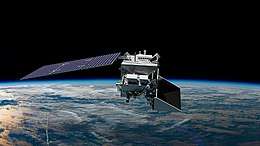Plankton, Aerosol, Cloud, ocean Ecosystem
Plankton, Aerosol, Cloud and ocean Ecosystem (PACE) is a NASA Earth-observing satellite mission that will continue and advance observations of global ocean color, biogeochemistry, and ecology, as well as carbon cycle, aerosols and clouds.[1] PACE data will be used to identify the extent and duration of phytoplankton blooms and improve understanding of air quality.[2] These and other uses of PACE data will benefit the economy and society, especially sectors that rely on water quality, fisheries and food security.[3]·[4]
 An artist’s concept of NASA’s PACE spacecraft in orbit. | |
| Mission type | Remote sensing |
|---|---|
| Operator | NASA |
| Website | pace |
| Mission duration | 3-10 years |
| Spacecraft properties | |
| Manufacturer | NASA Goddard Space Flight Center |
| Launch mass | 1,694 kg |
| Power | 1,000 watts |
| Start of mission | |
| Launch date | December 2022 |
| Rocket | Falcon 9, SpaceX |
| Launch site | Cape Canaveral, SLC-40 |
| Orbital parameters | |
| Reference system | Geocentric |
| Regime | Low Earth |
| Periapsis altitude | 676 km |
| Apoapsis altitude | 676 km |
| Inclination | 98° |
| Period | 2 day global coverage |
| Epoch | Planned |
The mission is currently in construction, after being proposed for cancellation under President's Trump FY 2018 budget but restored by Congress.[5] The PACE project is managed by NASA Goddard Space Flight Center.[6] The main instrument and bus are being designed and built at Goddard Space Flight Center.[7]
On 4 February 2020, NASA announced the selection of SpaceX to launch PACE on a Falcon 9. The total cost for NASA to launch PACE is US$80.4 million, including the launch service and other mission-related costs, according to the space agency. The PACE mission has a cost cap of $805 million.[8] The satellite is planned for launch on December 2022.[9]
Science overview
PACE has two fundamental science goals: "to extend key systematic ocean color, aerosol, and cloud data records for Earth system and climate studies, and to address new and emerging science questions using its advanced instruments, surpassing the capabilities of previous and current missions".[10] The ocean and atmosphere are directly connected, moving and transferring energy, water, nutrients, gases, aerosols, and pollutants. Aerosols, clouds, and phytoplankton can also affect one another.[10]
PACE will measure atmospheric particles and clouds that scatter and absorb sunlight. Improved characterization of aerosol particles will enable quantifying their impact on marine biology and ocean chemistry, as well as Earth's energy budget [10] and ecological forecasting.[10] PACE will enable scientists to better monitor fisheries, identify harmful algal blooms, and observe changes in marine resources. The color of the ocean is determined by the interaction of sunlight with substances or particles present in seawater such as chlorophyll, a green pigment found in most phytoplankton species. By monitoring global phytoplankton distribution and abundance, the mission will contribute toward understanding the complex systems that drive ocean ecology.[11]
Scientific instruments
The ocean play a critical role in supporting life on Earth as well as the global economy. To understand changes in ocean health related to climate change;[10] formulation of science objectives and sensor requirements for an advanced ocean biology satellite mission began in the year 2000 with a NASA agency-wide carbon cycle initiative that included ocean, terrestrial, and atmospheric disciplines. The instrument requirements for this ocean ecology mission are: [11]
- Ocean Color Instrument (OCI), is an optical spectrometer capable of measuring the color of the ocean from ultraviolet to shortwave infrared.[12] Wavelengths UV (350-400 nm), visible (400-700 nm), and near-infrared (700-885 nm), as well as several shortwave infrared bands.[10]
- SPEXone and HARP-2 are two polarimeters provided by the Netherlands and the University of Maryland Baltimore County, respectively, that will measure aerosol characterization, cloud droplet size, and ice particle shape.
History
PACE was originally [late 2014, early 2015] called Pre-Aerosol,_Cloud,_ocean_Ecosystem (PACE).[13]
See also
References
- NASA Ocean Color - PACE. Gene C. Feldman, NASA Goddard Space Flight Center.
- "IOCCG News May 2017".
- "NASA Earth Science Decadal Survey".
- Bridenstine offers senators reassurances on NASA programs. Jeff Foust. Space News. 24 May 2018.
- NASA receives $20.7 billion in omnibus appropriations bill. Jeff Foust. Space News. 22 March 2018.
- "NASA press release dated March 13, 2015".
- "NASA press release dated July 20, 2016".
- https://spaceflightnow.com/2020/02/05/spacex-wins-contract-to-launch-nasas-pace-earth-science-mission/- 6 February 2020
- https://spaceflightnow.com/2020/02/05/spacex-wins-contract-to-launch-nasas-pace-earth-science-mission/ - 6 February 2020
- About PACE. NASA.
- PACE - Overview. NASA.
- PACE - OCI Instrument. NASA
- Pre-Aerosol, Cloud, and ocean Ecosystem (PACE) Mission March 2015